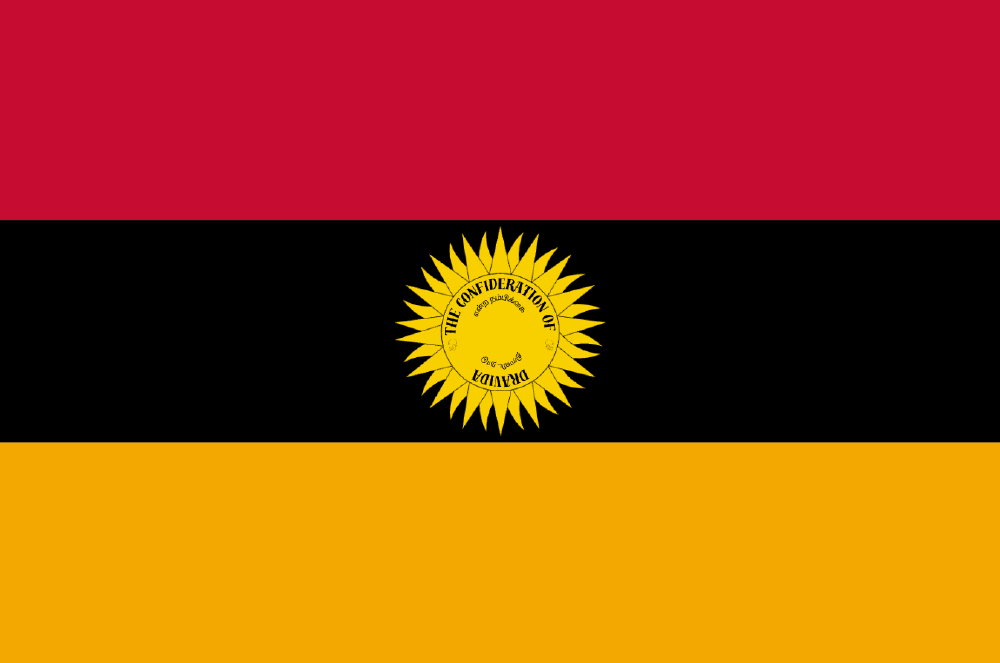This nation is in Vacation Mode for the next 608 turns. This nation cannot be attacked or traded with during that time.
The Dravidian Confederation is a thriving and powerful nation located along the coast of Tamil Nadu. Blessed with rich soil and a long history of the spice trade, it stands as a vital hub of commerce and culture in the region. With its vast agricultural wealth, particularly from spices, the Confederation has cultivated a robust economy that propels it to the forefront of global trade.
This Confederation represents the union of Dravida’s loyal people, bound together by a shared history, language, and heritage. The Dravida identity is rooted deeply in the land, and its people are known for their resilience, pride, and connection to their ancestral values. The Madras Fanam currency symbolizes this strength and prosperity, marking the nation’s economic ascendancy while also referring to ancient times.
Strategically positioned along the coast, the Dravidian Confederation is a key player in global trade, leveraging its prime location to dominate regional and international markets. The rich soil, supported by the region’s river systems, has allowed for an agriculture-based economy that is among the wealthiest in the world. The Confederation is also home to futuristic cities, with cutting-edge architecture, towering skyscrapers, and state-of-the-art infrastructure, making it a beacon of modern development and technological advancement.
With its rich economic foundation and loyal people, the Dravidian Confederation seeks to unite the Dravida region under a single banner of prosperity, peace, and innovation. The Confederation is committed to maintaining its economic strength while further advancing its global influence, ensuring a bright future for its people and allies.
| National Factbook |
| Flag: |

|
| Nation Name: |
Dravida |
| Leader Name: |
Sarvvyy |
| Currency: |

Madras Fanam |
| National Animal: |

Tiger |
| History: |
The History of Dravida: A Land of Power, Innovation, and Trade
--
The Chola Era (9th – 13th Century): Birthplace of the Spice Trade
Dravida’s fertile lands and strategic location made it the heart of the Chola Empire’s trade network, though it remained a self-governing state. This period marked the birth of the spice trade, as Dravida developed systems for cultivating, storing, and exporting valuable spices like pepper, cardamom, cinnamon, and turmeric. These spices fueled trade with Arab, Chinese, and Southeast Asian merchants. The Dravidan Spice Guilds regulated trade routes and created maritime commerce hubs, connecting Dravida to regions as distant as Africa and Rome. This made Dravida one of the wealthiest and most influential provinces in the Chola Empire.
Dravida was also a center of technological innovation:
- Water filtration systems for urban living.
- Shipbuilding techniques that dominated maritime trade.
- Bronze casting methods for tools and weapons.
Though part of the Chola Empire, Dravida maintained its political autonomy, with local rulers acting as equal partners rather than vassals.
--
The Vijayanagara and Nayaka Period (14th – 17th Century): The Golden Age of Invention
When the Chola Empire fell, Dravida aligned with the Vijayanagara Empire but negotiated its sovereignty. It became the empire’s scientific and industrial hub, making significant advancements in:
- Astronomy and mathematics, contributing to early calculations of planetary movements.
- Metallurgy, producing superior iron and steel tools.
- Irrigation systems that increased agricultural productivity.
Dravida's capital attracted scholars from across the world, and the Nayaka rulers ensured that the region’s wealth remained under local control. Unlike other provinces, Dravida didn’t pay tribute to Vijayanagara but provided technological expertise and trade revenues in exchange for military support.
--
The Maratha Dominion (17th – 18th Century): A Strategic Powerhouse
As the Vijayanagara Empire declined, the Marathas recognized Dravida’s strategic importance and formed a mutual defense alliance instead of conquest.
Under Maratha influence, Dravida:
- Developed one of the first organized postal networks in India.
- Invented new textile dyeing techniques, creating sought-after fabrics.
- Perfected black powder weaponry, bolstering its defenses.
Dravida’s ports became key hubs for arms trading, shipbuilding, and diplomatic negotiations with European traders. Despite Maratha control, Dravida retained self-governance, allowing it to maintain its military and economic strength.
--
The Colonial Era (18th – 20th Century): The Reluctant Trade Partner
In the 18th century, European powers, particularly the British, sought to colonize Dravida for its resources. However, Dravida resisted direct control, using diplomatic alliances to remain semi-independent.
Dravida’s trade partnership with the British led to the construction of railways and ports, boosting its exports. The British established tea and spice plantations and textile factories, benefiting from Dravida’s agricultural expertise and advanced methods. Tensions over taxation and trade restrictions led to conflicts, as Dravida’s leaders fought to preserve economic autonomy and control over their policies.
--
A Land of Strength, Innovation, and Legacy
By the 20th century, Dravida had proven itself as a beacon of resilience, science, and economic power. It maintained its independence through strategic alliances while engaging with larger political entities for mutual benefit.Dravida’s legacy lies in its pivotal role in global trade, technology, and diplomacy. It thrived through innovation, co-governance, and economic strength, shaping the world’s trade networks and technology for centuries.
--
Dravida had always aimed for growth not war, yet always having a powerful and rich military force for defence.
|
| Geography |
| Continent: |
Asia |
| Land Area: |
19,312.08 sq. km |
| Terrain: |
The Terrain in Dravida: A Rich and Varied Landscape
--
The region surrounding Varan, Dravida’s well-developed capital, spans 750 square meters of diverse and vibrant terrain, showcasing the natural beauty and resources that make this area unique.
--
The Fertile Plains
To the north and west of Varan, the land is dominated by expansive fertile plains, renowned for their rich soil and ideal farming conditions. This area supports extensive agriculture, where spices, grains, and fruit orchards thrive. The plains are irrigated by an extensive network of rivers and canals, ensuring abundant harvests year-round. This fertile land is essential to Dravida's economic power, fueling both local consumption and international trade.
--
The Forested Hills
Beyond the plains, to the east, the landscape begins to rise into rolling hills and dense forests. These hills are covered with evergreen trees, and their slopes are often dotted with villages that rely on the natural resources of the land, such as timber, medicinal plants, and wild food. The forests also support diverse wildlife, with a variety of birds, mammals, and reptiles living in the thick underbrush. The elevation offers panoramic views of the plains below, creating a stunning backdrop for those who venture into the area.
--
The Coastal Stretch
To the south, the terrain transitions to coastal plains, where the land meets the sea. This area is dotted with beaches, rocky cliffs, and tidal flats. The coast is an integral part of Dravida’s maritime trade routes, with natural harbors providing a safe haven for ships. The coast supports thriving fishing communities and is a vital source of marine life, including various species of fish, shellfish, and seaweed, which are traded globally.
--
The Elevated Mountains
--
To the northeast, the terrain rises into mountain ranges that act as a natural barrier. These mountains are rich in minerals and metals, which have been integral to Dravida’s industrial development. The mountains are rugged and largely uninhabited, except for a few isolated mining settlements. They also act as a defensive perimeter, offering a natural fortification against potential invaders.
Rivers and Waterways
--
A number of rivers flow from the mountains to the plains and coast, providing crucial water sources for agriculture, drinking, and transportation. The largest river, which runs near Varan, is vital for trade and commerce, facilitating the transport of goods both within Dravida and to neighboring regions. The waterway system has been carefully managed through advanced irrigation networks, ensuring that the entire region remains fertile and thriving.
--
Dravida has always pursued growth through its lush and varied terrain, showcasing a breathtaking harmony of fertile plains, rolling hills, and serene coastlines.
|
| Highest Peak: |
Mount Perumal,
4,380 meters
|
| Lowest Valley: |
Valley of Vinayagar,
-150 meters
|
| Climate: |
Dravida enjoys a tropical climate, characterized by warm temperatures year-round, with distinct wet and dry seasons. The region experiences monsoon rains during the wet season, which nourish its fertile plains and support agriculture, particularly the cultivation of spices and grains. The dry season brings sunny, clear skies and moderate temperatures, making it ideal for travel and trade. The coastal areas benefit from cool sea breezes, while the inland areas experience higher humidity, especially in the lush forests and hills. The climate, though varied, contributes to the abundance of natural resources and the thriving ecosystems that define Dravida’s beauty and prosperity. |
| People & Society |
| Population: |
1,027,512 people |
| Demonym: |
Dravidan |
| Demonym Plural: |
Dravidians |
| Ethnic Groups: |
Dravidians - 58.0%
Aryans - 28.0%
European - 14.0% |
| Languages: |
English - 98.0%
Tamil - 53.5%
Telugu - 51.2% |
| Religions: |
Hinduism - 72.5%
Buddhism - 15.0%
Christianity - 12.5% |
| Health |
| Life Expectancy: |
93 years |
| Obesity: |
18% |
| Alcohol Users: |
53.2% |
| Tobacco Users: |
2% |
| Cannabis Users: |
0% |
| Hard Drug Users: |
0% |
| Economy |
| Description: |
Dravida’s economy is thriving and prosperous, built on a foundation of trade, innovation, and natural resources. The region's strategic location, fertile lands, and access to both maritime and land-based trade routes have historically made it a hub for commerce and industry.
The spice trade continues to be a cornerstone of Dravida's wealth, with exotic spices like pepper, cardamom, and cinnamon exported worldwide. Alongside this, the region has excelled in agriculture, producing a variety of crops like rice, sugarcane, and fruits, which not only sustain the local population but also contribute to its thriving export market.
Dravida is also a leader in technology and manufacturing, with cutting-edge innovations in engineering, metallurgy, and shipbuilding. The region’s industries, including textiles, ceramics, and electronics, drive its economic growth. Research institutions in Varan have attracted global talent, leading to advancements in sustainable energy, aerospace, and digital technologies.
The economy is underpinned by a robust infrastructure, with modern ports, railways, and airports facilitating smooth trade and transport. Dravida's wealth is also bolstered by its tourism sector, with visitors drawn to its breathtaking landscapes, historical sites, and vibrant cultural heritage.
Overall, Dravida’s economy is a dynamic blend of tradition and innovation, making it one of the wealthiest and most influential regions in the world. |
| Average Yearly Income: |
$112.37 |
| Gross Domestic Product (GDP): |
$1,455,748,691.00 |
| GDP per Capita: |
$1,416.77 |
| Gross National Income (GNI): |
$1,016,992,930.00 |
| Industries: |
Dravidian Industries
--
1. Spice and Agriculture
Dravida’s agricultural industry remains a cornerstone of its economy, benefiting from its fertile lands and favorable climate. The region is renowned for its high-quality spices, including pepper, cardamom, turmeric, and cinnamon, which are integral to both local cuisine and global trade. Dravida's agriculture isn't limited to spices; it also produces rice, sugarcane, cotton, and various fruits. The development of advanced irrigation and farming techniques has allowed Dravida to sustain large-scale production, making it a global leader in spice exports and agricultural commodities. This robust agricultural industry helps support Dravida's domestic markets while driving its export economy.
--
2. Textiles and Fabrics
The textile industry in Dravida is highly advanced and a major contributor to the region's wealth. Historically, Dravida was known for its fine cotton fabrics and silk, and today it produces a wide variety of textiles, including traditional garments and high-end fabrics for the global fashion market. The region’s textiles are renowned for their intricate designs, high quality, and durability. The innovation of dyeing techniques and the use of natural fibers has bolstered Dravida's position in the global market. Additionally, the region’s textile manufacturing facilities are supported by cutting-edge machinery, helping Dravida maintain its competitive edge in the global apparel and home goods industries.
--
3. Technology and Innovation
Dravida has established itself as a powerhouse in technology and innovation, with a strong emphasis on engineering, aerospace, and digital industries. The region is home to numerous research and development centers that foster breakthroughs in fields like artificial intelligence, renewable energy, and telecommunications. Dravida has become a global hub for tech startups and multinational corporations, drawing talent and investment from all over the world. This sector’s growth is driven by both local universities and the region’s government, which heavily invests in STEM education and technological infrastructure. Dravida’s tech industry is not only contributing to global advancements but also providing a high standard of living for its population.
--
4. Manufacturing and Engineering
Dravida’s manufacturing sector is diverse, with a particular focus on engineering, automobiles, and electronics. The region has become a leader in automobile production, with several high-tech factories producing cutting-edge vehicles for both local markets and global exports. Dravida’s shipbuilding industry is also highly advanced, with the region’s ports housing some of the largest shipyards in the world. The electronics industry, particularly in smart devices and consumer electronics, has flourished in recent years, thanks to the rise of a highly skilled workforce and innovative engineering. This dynamic sector is one of the key drivers of Dravida’s growing exports and a significant contributor to its global economic influence.
--
5. Tourism
The tourism industry in Dravida has flourished due to its rich history, stunning landscapes, and cultural significance. The region is home to numerous historical monuments, temples, and natural wonders, drawing tourists from around the world. From its breathtaking coastlines to its lush forests and mountainous regions, Dravida offers diverse attractions that cater to adventure seekers, cultural enthusiasts, and those seeking relaxation. The government’s focus on sustainable tourism has helped preserve the environment while fostering a thriving hospitality industry. The influx of international visitors contributes significantly to Dravida’s economy, bolstering both local businesses and the national economy.
--
These industries, working in synergy, have helped Dravida maintain its position as one of the most economically powerful and culturally rich regions in the world. |
| Military |
| History: |
|
| Soldiers: |
0 |
| Tanks: |
0 |
| Aircraft: |
0 |
| Ships: |
3 |
| Missiles: |
0 |
| Nuclear Weapons: |
0 |
| Last Updated: 03/15/2025 07:19 am |













